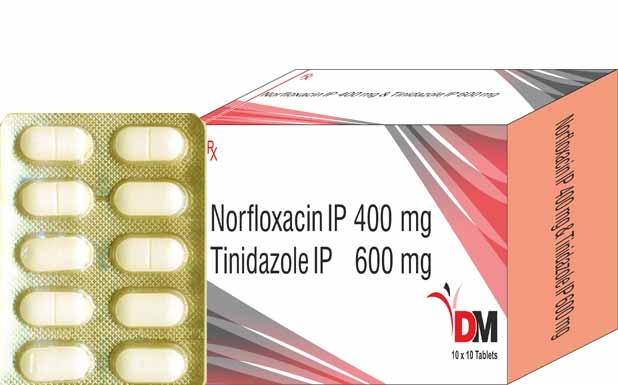Tinidazole is an anti-parasitic drug used against protozoan infections. Tinidazole is used to treat trichomoniasis (a sexually transmitted disease that can affect men and women), giardiasis (an infection of the intestine that can cause diarrhea, gas, and stomach cramps), and amebiasis (an infection of the intestine that can cause diarrhea, gas, and stomach cramps and can spread to other organs such as the liver). Tinidazole is in a class of medications called antiprotozoal agents. It works by killing the organisms that can cause infection.
Indications:
●Norfloxacin is usually efficacious for urinary tract infections and for the treatment of uncomplicated gonorrhea (urethritis or cervicitis).
●Tinidazole is used to treat certain types of vaginal infections (bacterial vaginosis, trichomoniasis). It is also used to treat certain types of parasite infections (giardiasis, amebiasis).
Pharmacology:
Mechanism of action:
Norfloxacin:
Norfloxacin inhibits bacterial deoxyribonucleic acid synthesis and is bactericidal. molecular level, three specific events are attributed to norfloxacin in E. coli cells:
●Inhibition of the ATP-dependent DNA supercoiling reaction catalyzed by DNA gyrase,
●Inhibition of the relaxation of supercoiled DNA,
●Promotion of double-stranded DNA breakage.
Tinidazole:
Tinidazole is a second generation small-molecule antiprotozoal agent. While the precise mechanism of action is unknown, cell extracts from Trichomonas have been shown to reduce the molecule's nitro group, producing cytotoxic free radicals.
Pharmacokinetics:
Norfloxacin:
Absorption:Norfloxacin is rapidly absorbed; 30% to 40% absorbed in fasting patients. Food and dairy products decrease absorption. Steady state is 2 days, C max is 0.8 to 2.4 mcg/mL, and T maxis approximately 1 h after dosing.
Distribution:Norfloxacin- Protein binding is 10% to 15% and crosses the placenta.
Metabolism:Norfloxacin-Suggested as first-pass metabolism; however, further study is needed. Tinidazole is significantly metabolized in humans prior to excretion.
Elimination: Norfloxacin is eliminated in urine (26% to 32% as norfloxacin, 5% to 8% as active metabolites) and feces (30%).
Tinidazole:
Absorption:Tinidazole absorbs rapidly and completely under fasting conditions. Oral absorption of tinidazole is found to be 100%.
Distribution:Tinidazole is distributed into virtually all tissues and body fluids and also crosses the blood-brain barrier. The apparent volume of distribution is about 50 liters. Plasma protein binding of tinidazole is 12%. Tinidazole crosses the placental barrier and is secreted in breast milk.
Metabolism:Tinidazole is partly metabolized by oxidation, hydroxylation, and conjugation. Tinidazole is the major drug-related constituent in plasma after human treatment, along with a small amount of the 2-hydroxymethyl metabolite.
Elimination: The plasma half-life of tinidazole is approximately 12-14 hours. Tinidazole is excreted by the liver and the kidneys. Tinidazole is excreted in the urine mainly as unchanged drug (approximately 20-25% of the administered dose). Approximately 12% of the drug is excreted in the feces.
Drug Interactions:
●Azole antifungals (eg, ketoconazole) or cimetidine because they may increase the risk of tinidazole's side effects.
●Barbiturates (eg, phenobarbital), phenytoin, or rifampin because they may decrease tinidazole's effectiveness.
●All fluoroquinolone agents interact with multivalent cation containing products, such as aluminium or magnesium containing antacids and the product containing antacids and calcium, iron or zinc.
Side Effects:
The most common side effects reported with are upset stomach, bitter taste, hallucinations, anxiety. Norfloxacin may cause problems with bones, joints, and tissues around joints in children.
Contraindications:
Hypersensitivity or tendonitis associated with the use of norfloxacin or any member of the quinolone class of antimicrobial agents; hypersensitivity to any component of the product.
Pregnancy :
Category C .
Lactation :
Undetermined.
Children :
Safety and efficacy not established (oral form).
